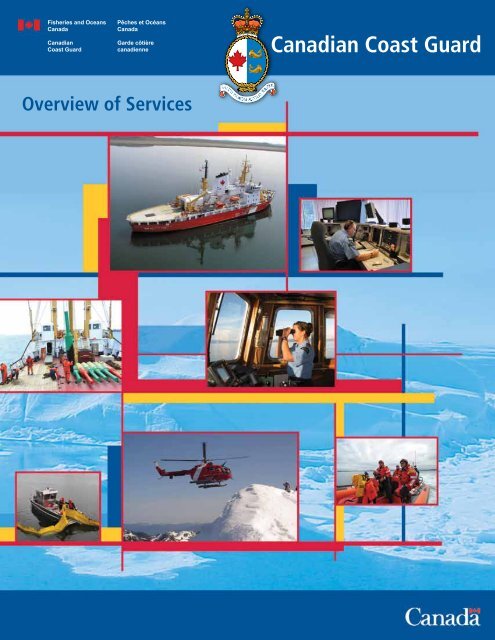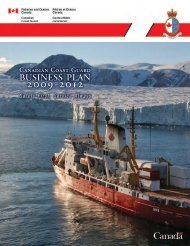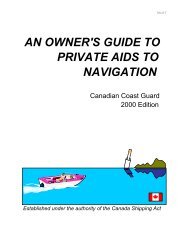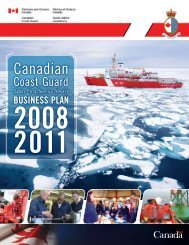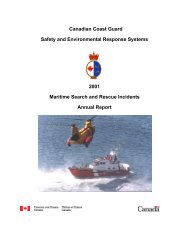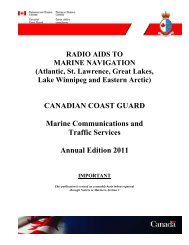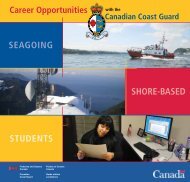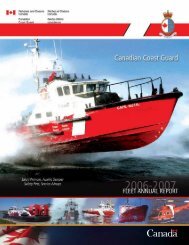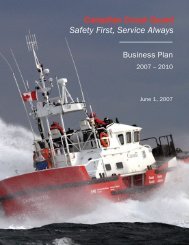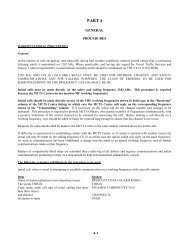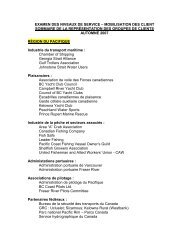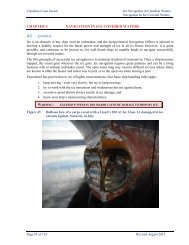Recruitment Kit's Overview of Services - Canadian Coast Guard
Recruitment Kit's Overview of Services - Canadian Coast Guard
Recruitment Kit's Overview of Services - Canadian Coast Guard
You also want an ePaper? Increase the reach of your titles
YUMPU automatically turns print PDFs into web optimized ePapers that Google loves.
Fisheries and Oceans<br />
Canada<br />
<strong>Canadian</strong><br />
<strong>Coast</strong> <strong>Guard</strong><br />
Pêches et Océans<br />
Canada<br />
Garde côtière<br />
canadienne<br />
<strong>Canadian</strong> <strong>Coast</strong> <strong>Guard</strong><br />
<strong>Overview</strong> <strong>of</strong> <strong>Services</strong><br />
<strong>Overview</strong> <strong>of</strong> <strong>Services</strong> www.ccg-gcc.gc.ca 1
Photo: Pauli Thurner<br />
Photo: Pauli Thurner<br />
Published by:<br />
National Labour Force Renewal Directorate<br />
Fisheries and Oceans Canada<br />
<strong>Canadian</strong> <strong>Coast</strong> <strong>Guard</strong><br />
Ottawa, Ontario<br />
K1A 0E6<br />
<strong>Overview</strong> <strong>of</strong> <strong>Services</strong><br />
1st Edition – July 2010<br />
Available on the CCG Internet site:<br />
www.ccg-gcc.gc.ca<br />
DFO/2010-1668<br />
© Her Majesty the Queen in Right <strong>of</strong> Canada 2010<br />
Cat. No. Fs154-24/2010<br />
ISBN 978-1-100-51644-8-paper<br />
ADD Cat. No. Fs154-24/2010E-PDF<br />
ISBN 978-1-100-15907-2-PDF<br />
www.ccg-gcc.gc.ca <strong>Canadian</strong> <strong>Coast</strong> <strong>Guard</strong>
<strong>Overview</strong> <strong>of</strong> the <strong>Canadian</strong> <strong>Coast</strong> <strong>Guard</strong><br />
What is the <strong>Canadian</strong> <strong>Coast</strong> <strong>Guard</strong>?<br />
Photo: National Photo Library<br />
The <strong>Canadian</strong> <strong>Coast</strong> <strong>Guard</strong> (CCG)<br />
is a national institution that provides<br />
maritime programs and services to<br />
<strong>Canadian</strong>s. The <strong>Coast</strong> <strong>Guard</strong> fleet,<br />
Canada’s strong and visible presence,<br />
patrols the longest coastline and<br />
inland waterway, as well as the largest<br />
freshwater system <strong>of</strong> our planet.<br />
From agile search and rescue<br />
lifeboats to icebreakers capable <strong>of</strong><br />
breaking through two-metre-thick<br />
ice and six-metre-high ridges, our<br />
vessels are tasked to various programs<br />
and crewed by some 2,400 skilled<br />
seagoing personnel. The CCG<br />
operates a fleet <strong>of</strong> 116 vessels and 23<br />
helicopters. On the ground, over<br />
2,100 employees across Canada<br />
support our seagoing staff serving as<br />
the backbone <strong>of</strong> the agency.<br />
The CCG has received funding in<br />
the past few years for 17 new vessels,<br />
12 <strong>of</strong> which are to replace existing<br />
vessels and five that are additions to<br />
our fleet. The <strong>Coast</strong> <strong>Guard</strong> will need<br />
to hire some 100 additional seagoing<br />
and shore-based employees as a<br />
result.<br />
<strong>Services</strong><br />
The <strong>Canadian</strong> <strong>Coast</strong> <strong>Guard</strong><br />
prides itself in ensuring it<br />
meets the expectations <strong>of</strong><br />
the nation and the world.<br />
While implementing the<br />
latest in nautical technologies<br />
and relying on the skill<br />
and pr<strong>of</strong>essionalism <strong>of</strong> its<br />
employees, the CCG <strong>of</strong>fers<br />
first-rate service in:<br />
n Aids to Navigation;<br />
n Icebreaking;<br />
n Search and Rescue;<br />
n Maritime Security;<br />
n Environmental Response;<br />
n Marine Communications and<br />
Traffic <strong>Services</strong>;<br />
n Scientific Research; and,<br />
n Waterways Management.<br />
Where is the <strong>Canadian</strong><br />
<strong>Coast</strong> <strong>Guard</strong> located?<br />
The CCG operates out <strong>of</strong> five regions: Pacific,<br />
Central & Arctic, Quebec, Maritimes and<br />
Newfoundland & Labrador. Our National<br />
Headquarters is located in Ottawa and the<br />
<strong>Canadian</strong> <strong>Coast</strong> <strong>Guard</strong> College is in Sydney,<br />
Nova Scotia.<br />
<strong>Overview</strong> <strong>of</strong> <strong>Services</strong> www.ccg-gcc.gc.ca 1
On any given day, the<br />
<strong>Canadian</strong> <strong>Coast</strong> <strong>Guard</strong>:<br />
n Saves eight lives;<br />
n Assists 55 people in 19 search and<br />
rescue cases;<br />
n <strong>Services</strong> 55 aids to navigation;<br />
n Handles 1,547 marine radio<br />
contacts;<br />
n Manages 2,325 commercial ship<br />
movements;<br />
n Escorts four commercial ships<br />
through ice during the ice<br />
season;<br />
n Carries out 11 fisheries patrols;<br />
n Supports three hydrographic<br />
missions;<br />
n Supports eight scientific surveys;<br />
n Deals with three reported<br />
pollution events; and,<br />
n Surveys five kilometres <strong>of</strong><br />
navigation channel bottom.<br />
Aids to Navigation<br />
The CCG is tasked with ensuring the safe passage <strong>of</strong> marine traffic<br />
through Canada’s vast and challenging waterways and coastlines<br />
using a variety <strong>of</strong> aids to navigation. Some <strong>of</strong> the first ones that<br />
come to mind are the physical ones boaters can see, these include<br />
lighthouses and buoys, foghorns, as well as beacons and reflectors.<br />
Long-range aids provide position information to vessels. Through<br />
technological advances, they have improved their accuracy<br />
in positioning from 400 metres with the LORAN C service<br />
implemented in the 1970s to within 10 metres with the more recent<br />
Differential Global Positioning System (DGPS).<br />
The CCG is also working to implement the concept <strong>of</strong> e-Navigation,<br />
which will enhance the ability to share information electronically on<br />
a timely basis between ships. This will significantly enhance safety by<br />
making navigation easier for all!<br />
Photo: Trinidad Ruiz<br />
Photo: Bernard Parizeau<br />
Photo: Pacific Region<br />
2 www.ccg-gcc.gc.ca <strong>Canadian</strong> <strong>Coast</strong> <strong>Guard</strong>
Icebreaking<br />
Frozen waters in May are as uniquely <strong>Canadian</strong> as<br />
the Icebreaking Program provided by the CCG.<br />
The <strong>Canadian</strong> <strong>Coast</strong> <strong>Guard</strong> responds to about<br />
1,500 requests a year for icebreaking support.<br />
Working in partnership with Environment Canada’s<br />
<strong>Canadian</strong> Ice Service, the CCG allows safe and<br />
timely movement <strong>of</strong> maritime traffic in Canada’s<br />
ice-covered waters by:<br />
n Freeing trapped vessels and escorting ships in ice;<br />
n Maintaining open tracks through ice firmly attached to<br />
the shore;<br />
n Re-supplying isolated northern settlements;<br />
n Providing ice information and ice routing information to<br />
assist vessels navigating through or around ice-covered<br />
waters;<br />
n Conducting harbour breakouts; and,<br />
n Reducing the risk <strong>of</strong> flooding on the St. Lawrence<br />
Seaway by monitoring, preventing and breaking up ice<br />
jams.<br />
Search and Rescue<br />
Photo: National Photo Library<br />
Photo: National Photo Library<br />
Photo: Maritimes Region<br />
Search and Rescue (SAR) personnel are<br />
always at the ready as disasters can occur any<br />
time, anywhere. The SAR Program involves<br />
searching for and assisting people, ships or<br />
other craft that are, or are believed to be, in<br />
imminent danger. The highly trained search<br />
and rescue coordinators and crews <strong>of</strong> the rescue<br />
centres are responsible for conducting the<br />
planning, coordination and control <strong>of</strong> search<br />
and rescue operations.<br />
Our five rescue coordination centres have<br />
the ability to make use <strong>of</strong> any CCG vessel,<br />
including 41 dedicated search and rescue<br />
lifeboats stationed strategically throughout the<br />
country to provide the best possible response<br />
to SAR incidents, 24 hours a day, 365 days a<br />
year. The <strong>Canadian</strong> <strong>Coast</strong> <strong>Guard</strong> Auxiliary,<br />
a volunteer organization consisting <strong>of</strong> about<br />
4,300 members and 1,200 vessels, is a valuable<br />
support to the SAR Program.<br />
Photo: Jason Rimmer<br />
<strong>Overview</strong> <strong>of</strong> <strong>Services</strong> www.ccg-gcc.gc.ca 3
Maritime Security<br />
Photo: National Photo Library<br />
Environmental Response<br />
While the <strong>Canadian</strong> <strong>Coast</strong> <strong>Guard</strong> remains an unarmed<br />
organization, it assists in our national maritime<br />
security and sovereignty. The CCG <strong>of</strong>fers vessels<br />
and shore-based infrastructure to organizations such<br />
as the Royal <strong>Canadian</strong> Mounted Police (RCMP) and<br />
the <strong>Canadian</strong> Forces, as well as providing surveillance<br />
through modern technology.<br />
The CCG contributes to maritime security through<br />
the operation <strong>of</strong> the Automatic Identification System<br />
(AIS) and the development <strong>of</strong> the Long Range<br />
Identification and Tracking (LRIT) system. AIS<br />
involves the surveillance and identification <strong>of</strong> vessels<br />
approaching and operating within the Great Lakes and<br />
up to 40 nautical miles from Canada’s east and west<br />
coasts. The LRIT system will collect positional data<br />
on <strong>Canadian</strong> flag vessels, international vessels destined<br />
for <strong>Canadian</strong> ports, and vessels transiting within 1,000<br />
nautical miles <strong>of</strong> Canada’s shores.<br />
Photo: National Photo Library<br />
Photo: Pauli Thurner<br />
It may be a messy job, but the<br />
CCG takes the lead in ensuring<br />
the cleanup <strong>of</strong> all ship-source and<br />
mystery spills into the marine<br />
environment in waters under<br />
<strong>Canadian</strong> jurisdiction and for<br />
supporting other countries under<br />
international agreement.<br />
With experienced pr<strong>of</strong>essionals,<br />
the CCG minimizes the<br />
environmental, economic<br />
and public safety impacts <strong>of</strong><br />
marine pollution incidents by<br />
investigating reports <strong>of</strong> marine<br />
pollution in Canada. Working<br />
with commercial partners, we<br />
monitor and manage cleanup<br />
efforts. Our personnel are on<br />
standby 24 hours a day, seven<br />
days a week to investigate or<br />
initiate a response to pollution<br />
incident reports that are received<br />
regionally, nationally and<br />
internationally.<br />
Photo: Newfoundland and Labrador Region<br />
4 www.ccg-gcc.gc.ca <strong>Canadian</strong> <strong>Coast</strong> <strong>Guard</strong>
Marine Communications and Traffic <strong>Services</strong><br />
Marine Communications and Traffic <strong>Services</strong> (MCTS) are<br />
the eyes and ears <strong>of</strong> <strong>Canadian</strong> marine traffic. It is their duty<br />
to provide service to clients and stakeholders, such as the<br />
marine industry, recreational boaters, fishers, international<br />
government agencies, other federal<br />
government departments as well as<br />
provincial governments.<br />
The MCTS Program contributes to the<br />
safety <strong>of</strong> life at sea and the protection <strong>of</strong><br />
the marine environment. It is through<br />
the MCTS Program that search and<br />
rescue responders are notified <strong>of</strong><br />
persons or vessels in distress.<br />
Photo: Marie-Pier Malboeuf<br />
Twenty-two MCTS centres, staffed by 340 qualified<br />
MCTS Officers, provide services across our five regions.<br />
Annually, the centres respond to more than 1,600 vessels<br />
with defective or deficient equipment. They also monitor<br />
in excess <strong>of</strong> 850,000 vessel movements, <strong>of</strong> which more than<br />
23,000 are tankers.<br />
Scientific Research<br />
Photo: National Photo Library<br />
The CCG supports the Science Program <strong>of</strong> Fisheries<br />
and Oceans Canada by providing trained crewmembers<br />
on board both specialized and multitasked vessels such<br />
as research trawlers and hydrographic survey vessels.<br />
The crew supports scientists and technicians in a<br />
variety <strong>of</strong> specialized areas, such as:<br />
Photo: Rachelle Smith<br />
n Research fishing for a variety <strong>of</strong> commercial species;<br />
n Conducting surveys on acoustics, hydrography, geophysics,<br />
marine species stock assessment and benthic habitats and<br />
organisms;<br />
n Conducting marine mammal and seabird enumeration,<br />
identification, tracking and bioassessment;<br />
n Collecting plankton, larvae and phytoplankton; and,<br />
n Taking bottom sediment samples and coring.<br />
Photo: Rick Krishfield<br />
<strong>Overview</strong> <strong>of</strong> <strong>Services</strong> www.ccg-gcc.gc.ca 5
Waterways Management<br />
The Waterways Management Program enables the<br />
CCG to help ensure safe and efficient navigation,<br />
supports protection <strong>of</strong> the marine environment and<br />
facilitates marine trade and commerce.<br />
The core activities <strong>of</strong> the Program include:<br />
n Providing channel design guidelines to help ensure that ship<br />
channel design, maintenance and usage is safe, efficient<br />
and environmentally sound;<br />
n Maintaining the international shipping channels in the<br />
Great Lakes system;<br />
n Managing the maintenance <strong>of</strong> the St. Lawrence ship<br />
channel;<br />
n Providing channel safety information to users, such as<br />
channel bottom conditions and water-depth forecasts;<br />
n Operating/maintaining channel marine structures, such as<br />
ice control structures; and,<br />
n Supporting the International Joint Commission in controlling<br />
levels and flows in the St. Lawrence River system.<br />
There are more than 100,000 transits in our waters<br />
each year, including some 36,000 domestic and<br />
commercial arrivals. Millions <strong>of</strong> recreational and<br />
touring boaters also use our commercial waterways<br />
each year, making this program vital to tourism.<br />
Photo: National Photo Library<br />
Photo: Trinidad Ruiz<br />
Photo: Randy Russell<br />
Photo: Randy Russell<br />
6 www.ccg-gcc.gc.ca <strong>Canadian</strong> <strong>Coast</strong> <strong>Guard</strong>


